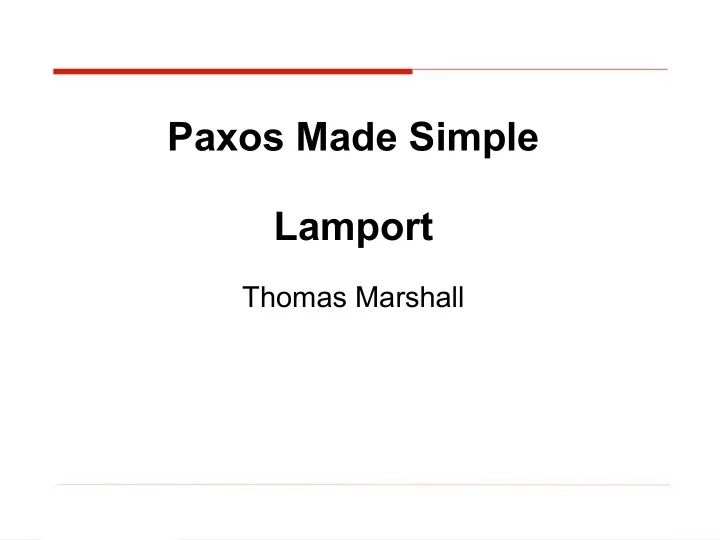

Paxos Made Simple Lamport Thomas Marshall
Motivation ● We need a way to maintain consistency in a distributed system in the presence of failures. ● 2PC works, but can get “stuck”, so a consensus algorithm is better.
Background ● Jim Gray proposes 2PC in the 1970s, but it blocks on single node failures. ● Dale Skeen proposes 3PC in the 1980s, but it produces incorrect results in some situations. ● Leslie Lamport proposes Paxos in 1998; the original paper describes the ancient Greek civilization on the Paxos island.
Example ● Leader election (eg. Mesos and Zookeeper) – important to only have one leader at a time. ● Some node(s) propose to be leader, other nodes can accept or reject.
Paxos ● We want to choose a value and have every node in the cluster agree on the value. ● Three classes of agents: proposers, acceptors, learners. ● Failures are possible, but non-Byzantine.
Safety Properties ● Only a value that has been proposed may be accepted. ● Only a single value is chosen. ● An agent never learns that a value has been chosen unless it actually has been.
Algorithm ● A proposer selects a proposal number n and sends a request to the acceptors. ● If an acceptor has not already accepted a proposal with number greater than n , it responds that it can accept this proposal.
Algorithm (cont) ● If a proposer receives ready responses from a majority of acceptors, it sends an accept message. ● An acceptor that receives an accept message accepts the proposal unless it has responded to a prepare with a number greater than n .
Paxos Example acceptors prepare = 8 proposer prepare = 8 prepare = 8
Paxos Example acceptors highest proposed = 8 ready proposer ready highest proposed = 8 ready highest proposed = 8
Paxos Example acceptors highest proposed = 8 accept = (8, foo) proposer accept = (8, foo) highest proposed = 8 accept = (8, foo) highest proposed = 8
Paxos Example acceptors highest accepted = (8, foo) accepted = (8. foo) proposer accepted = (8. foo) highest accepted = (8, foo) accepted = (8. foo) highest accepted = (8, foo)
Paxos Example leaners success = (8, foo) proposer success = (8, foo) success = (8, foo)
Paxos Example (2) acceptors proposers prepare = (8, A) prepare = (8, A) A prepare = (8, A) B
Paxos Example (2) acceptors proposers ready highest proposed = (8, A) ready A highest proposed = (8, A) ready B highest proposed = (8, A)
Paxos Example (2) acceptors highest proposed = (8, A) prepare = (9, B) A highest proposed = (8, A) prepare = (9, B) B prepare = (9, B) highest proposed = (8, A)
Paxos Example (2) acceptors proposers highest proposed = (8, A) A highest proposed = (9, B) ready B ready highest proposed = (9, B)
Paxos Example (2) acceptors proposers accept = ((8, A), foo) highest proposed = (8, A) accept = ((8, A), foo) A highest proposed = (9, B) accept = ((8, A), foo) B highest proposed = (9, B)
Paxos Example (2) acceptors proposers accepted = ((8, A), foo) highest accepted = ((8, A), foo) A highest proposed = (9, B) B highest proposed = (9, B)
Paxos Example (2) acceptors proposers highest accepted = ((8, A), foo) accept = ((9, B), bar) A highest proposed = accept = ((9, B), bar) (9, B) B accept = ((9, B), bar) highest proposed = (9, B)
Paxos Example (2) acceptors proposers highest accepted = ((8, A), foo) A highest accepted = accepted = ((9, B), bar) ((9, B), bar) B accepted = ((9, B), bar) highest accepted = ((9, B), bar)
Paxos Example (2) acceptors proposers prepare = (10, A) highest accepted = ((8, A), foo) prepare = (10, A) A highest accepted = ((9, B), bar) prepare = (10, A) B highest accepted = ((9, B), bar)
Paxos Example (2) acceptors proposers ready = ((10, A), highest accepted = ((8, A), foo) ((8, A), foo) highest proposed = ready = ((10, A), (10, A) ((9, B), bar) A highest accepted = ((9, B), bar) ready = ((10, A), highest proposed = ((9, B), bar) (10, A) B highest accepted = ((9, B), bar) highest proposed = (10, A)
Paxos Example (2) acceptors proposers accept = ((10, A), highest accepted = bar) ((8, A), foo) highest proposed = accept = ((10, A), (10, A) bar) A highest accepted = ((9, B), bar) highest proposed = accept = ((10, A), (10, A) bar) B highest accepted = ((9, B), bar) highest proposed = (10, A)
Paxos Example (2) acceptors proposers accepted = ((10, A), highest accepted = bar) ((10, A), bar) accepted = ((10, A), bar) A highest accepted = ((10, A), bar) accepted = ((10, A), bar) B highest accepted = ((10, A), bar)
Progress ● You can imagine “dueling” proposers that continually propose higher and higher proposal numbers without any ever being accepted. ● Solution: distinguished proposer.
Recommend
More recommend